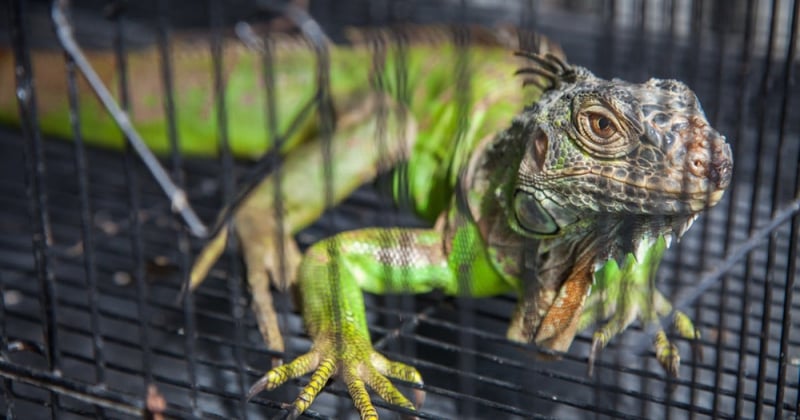
5 reasons why we need to protect reptiles from the exotic pet trade
News
Reptile Awareness Day (21st October) is the perfect opportunity to learn more about our scaly friends and why we need to protect them.
The reptile trade is both legal and illegal
Depending on the state, it is legal to breed some native reptiles in Australia as long as you have a license or permit. While little information is known about these breeding operations, we know that many reptiles are bred in unnatural and intense conditions, reducing these animals to mere commodities.
It is illegal to own a non-native or exotic reptile in Australia.
Laws about which reptiles can be wild caught and traded across borders vary between countries. CITES (the Convention on International Trade in Endangered Species of Wild Fauna and Flora) regulates the trade in endangered species, but approximately 91% of all reptiles remain unprotected.
Additionally, a growing body of scientific evidence shows that the legal trade fuels the demand, and therefore is a driver for the illegal trade of reptiles. The illegal trade includes poaching, breeding of prohibited animals and trading and sales of prohibited reptiles.
What is common to both the legal and illegal trade is how animal welfare becomes an afterthought. Reptiles should be treated as wildlife, not commodities.
Reptiles are carriers of zoonotic diseases
Salmonellosis is one type of zoonotic disease that reptiles can transmit to humans. Reptiles shed Salmonella from their intestinal tract and can carry it on their skin or shell. While harmless to reptiles, Salmonella infections can cause illness in humans and has led to hospitalisation and even death. Young children, the elderly, pregnant women and any immunocompromised individuals are at greatest risk.
Other zoonotic diseases that have been associated with the keeping of reptiles include Botulism, a serious and life-threatening illness caused by a toxin released by the Clostridium bacterium that causes paralysis and death; Campylobacteriosis, a bowel infection; Leptospirosis, a liver disease; and Trichinellosis, a disease of muscles, the nervous system and the heart and lungs. The severity of these diseases can range from minor discomfort to hospitalisation and death.
It is thought that 75% of new or emerging infectious diseases over the past three decades are zoonotic and mainly come from wildlife.
Reptiles cannot have their needs met in captivity
Providing food and water and housing a reptile in a tank is not enough to ensure good physical and psychological welfare. Reptiles must have the opportunity to engage in natural behaviours that help them cope with negative states (e.g., hunger and thirst) but also enable them to experience positive states, including but not limited to: engaging in seasonal movements and activities, social interactions with conspecifics (other members of the same species), maternal care and engaging in play behaviour.
While we know that pet owners do their best to take care of their animals, it is impossible to meet all of a reptile’s needs in captivity. In a home or an enclosure, there is no way to replicate the complex habitat, climate, space, and freedom these animals enjoy in the wild.
Adding to the issue is that many reptile species have not yet been studied in their natural environment. Consequently, the needs, and conditions recommended by the pet industry often don’t reflect what reptiles would experience in the wild but are rather based on information that has been gathered through the keeping of reptiles in captivity.
Photo by Ralph (Ravi) Kayden on Unsplash
Social media is fueling the reptile trade
Social media has helped popularise the keeping of exotic pets. Images and videos of reptiles and other wild animals in close proximity with humans affects people’s desirability to own exotic pets.
These images and videos depict a false narrative that keeping these wild animals as pets is easy, fun and acceptable for the animal.
Another consequence of social media is that it provides an easy way for traffickers and buyers to connect. People have been able to purchase wild animals on social platforms like Facebook Marketplace with just the click of a button.
Photo by Liam Edwards on Unsplash
Many reptile owners are unaware that their exotic pet is a wild animal
Being born in captivity does not make an animal domesticated or suitable as a pet. Unlike dogs and cats, reptiles such as snakes, lizards, and turtles are not domesticated; they have not co-evolved to live alongside humans. This might be a surprise to read because reptiles are sold as pets. But genetically and instinctually speaking these animals are wild, having similar traits (behaviours and psychological needs) as their wild counterparts.
We know that most people purchase a reptile as an exotic pet because they love animals. But many people are unaware of their complex needs and do not understand reptile-specific behaviours that indicate illness or distress. Where a dog or cat can usually vocalize or communicate in other ways if something is wrong, reptiles don’t necessarily have that ability. For example, sedentary behaviour is often misinterpreted as a natural state of being for certain reptile species. However, the actual behaviour that might be witnessed can be lethargic behaviour, an abnormal behaviour that often indicates something is wrong with the animal.
We encourage everyone to appreciate and respect reptiles by keeping them in the wild where they belong. We should only bring domesticated animals into our home as pets, whose needs can be completely met in captivity.
What is common to both the legal and illegal trade is how animal welfare becomes an afterthought. Reptiles should be treated as wildlife, not commodities.



